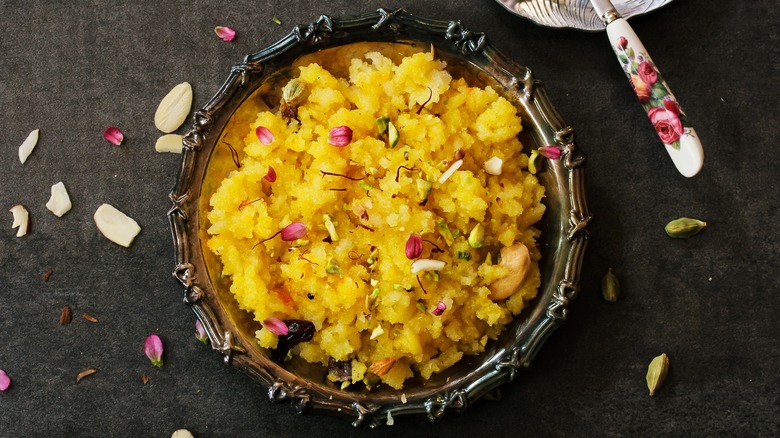Make Sooji Halwa, The Gift That Keeps On Giving On Diwali
Celebrated during October and November for five days, Diwali is known as the festival of light and is an important celebration for many people around the world from all faiths and religions (per BBC). Many people who observe Diwali celebrate by feasting with family and friends, enjoying fireworks, and honoring the Hindu goddess of wealth, Lakshmi. A festival wouldn't be complete without delicious food, and a few of the best traditional Diwali dishes including samosas, murukku, paneer tikka, namakpare, and sooji halwa, according to Times of India.
Thankfully, you don't have to only enjoy these dishes during Diwali, as they are fairly easy to make at home, and chef Palak Patel is just the person to help with her show "The Diwali Menu." In her show, Patel, who is also the owner of Dash & Chutney, invites friends and fellow chefs to share their Diwali recipes (per Food Network). For the show's second episode, Patel invites Archna Becker, chef and owner of Tandoori Pizza & Wing Company, to share her recipe for the popular Indian dish sooji halwa. Here's what you need to know about this unique Diwali dish.
Sooji halwa is a traditional Indian dish made from semolina flour and ghee
In the second episode of "The Diwali Menu" on Food Network, Becker shares her grandparents' recipe for sooji halwa with Patel. She begins by having a heavy-bottom pot on medium heat. Once the pot is hot enough, she adds ghee and fine semolina flour, whisking until they are combined and crumbly. Patel then adds sugar to a pot of boiling water and mixes it until the sugar melts. Becker adds cardamom seeds, saffron, and yellow food coloring to the flour mixture, adding some color to the sooji halwa, and Patel points out that her family omits the food coloring, making the sooji halwa white instead of yellow. The two discuss how this is an optional familial preference that's traditionally passed down and doesn't alter the sooji halwa's taste.
Becker also adds yellow food coloring to the sugar water and instructs Patel to slowly pour the sugar water into the flour mixture little by little while Becker continues whisking until all the water is poured in. The pair then cover the pot and leave the sooji halwa on medium heat for a few minutes until it becomes velvety and creamy. The sooji halwa is then portioned into bowls and garnished with dried rose petals, sliced almonds, and golden raisins. Patel and Becker also pair their sooji halwa with some chai tea and admire the dish's richness and pops of flavor.

